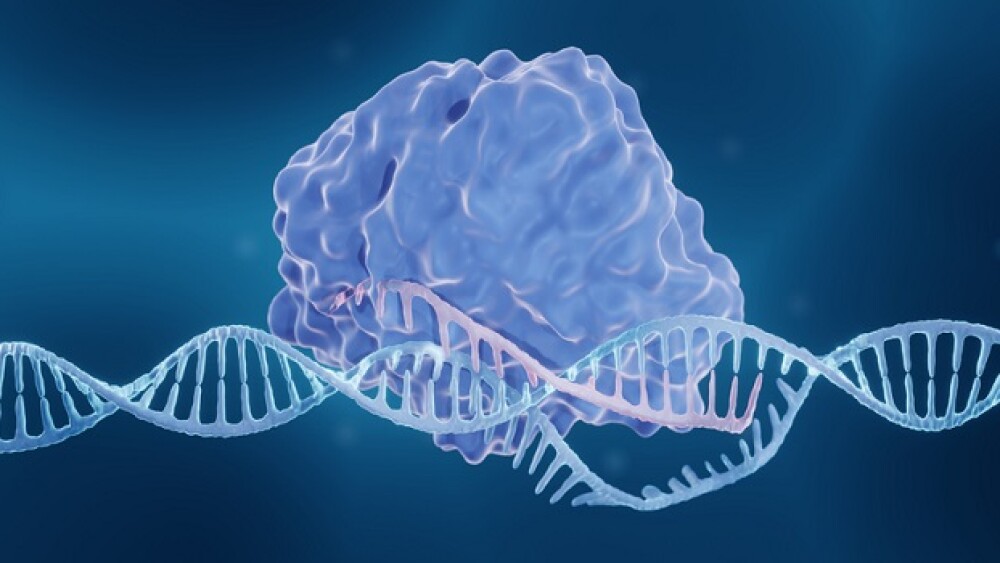Currently, there are no gene editing–based treatments on the market, but the technology continues its march toward potential FDA approval, with several products in mid- and late-stage trials.
Pictured: Illustration of CRISPR-Cas9 editing DNA / iStock, Artur Plawgo
Currently, there are no gene editing–based treatments on the market, but the technology continues its march toward potential FDA approval, with several products in mid- and late-stage trials. As these programs mature, 2023 could be a pivotal year for companies in the space. Here are some highlights to look forward to as the year progresses.
CRISPR Therapeutics/Vertex Pharmaceuticals
Just this month, collaborators CRISPR Therapeutics and Vertex Pharmaceuticals completed the submission of a rolling Biologics License Application (BLA) to the FDA for their product, exa-cel, as a potential treatment for sickle cell disease (SCD) and transfusion-dependent beta thalassemia (TDT).
Exa-cel is a CRISPR/Cas9 ex vivo treatment designed to increase levels of fetal hemoglobin in red blood cells. Fetal hemoglobin carries oxygen more efficiently than adult hemoglobin, which is defective in SCD and TDT. Exa-cel is currently undergoing two Phase III trials, CLIMB-111 and CLIMB-121, as well as an ongoing long-term follow-up study, CLIMB-131.
As such, exa-cel will be perceived as a viable alternative to existing treatments, which do not address the direct cause of the disease. For SCD, current treatments include narcotics, chemotherapy, vitamins and blood transfusions; for TDT, the only management option available is blood transfusions every two to four weeks.
If priority review is granted by the FDA within 60 days, the agency could approve the treatment by the end of this year.
Intellia Therapeutics
In March 2023, Intellia Therapeutics received a Regenerative Medicine Advanced Therapy (RMAT) designation from the FDA for NTLA-2002, an in vivo CRISPR-based treatment for hereditary angioedema (HAE). As a CRISPR-based investigational therapy designed to inactivate kallikrein B1, a pro-inflammatory glycoprotein, NTLA-2002 aims to prevent heart swelling attacks in HAE. Phase II trials are currently screening patients outside the U.S.
Established by the 21st Century Cures Act, the RMAT designation is important because Intellia gets access to early interactions with the FDA, accelerated approval support and priority review of NTLA-2002’s BLA. Having previously earned an Orphan Drug designation, NTLA-2002 is sure to be on the radar for regulators and investors this year.
In addition, Intellia is preparing an IND application submission for NTLA-2001 for mid-2023. Designed as an in vivo intravenous treatment for transthyretin (ATTR) amyloidosis, NTLA-2001 is undergoing Phase I trials with more data expected in 2023. Additional variations of ATTR amyloidosis such as ATTR amyloidosis with cardiomyopathy (ATTR-CM) and ATTR amyloidosis with polyneuropathy (ATTRv-PN) are also being investigated, with an ATTR-CM trial ready to be initiated by the end of 2023 and a Phase III ATTRv-PN trial currently being discussed with regulators.
Editas Medicine
Editas Medicine has undergone some internal restructuring in Q1 2023, with strategic reprioritization focusing on hemoglobinopathies and in vivo gene editing. A competitor to CRISPR Therapeutics, the company is currently working on EDIT-301 for SCD and TDT as well. Unlike CRISPR’s product, EDIT-301 uses AsCas12a to edit the genome instead of Cas9. AsCas12a only requires a single RNA molecule while Cas9 requires two RNA molecules.
However, Editas is currently behind others in the space as it initiates parallel patient dosing for SCD in the Phase I/II RUBY trial and doses the first patient for TDT in the Phase I/II EDITHAL trial. Updates for RUBY are expected by mid-2023 and data from EDITHAL will be available by the end of 2023.
Beam Therapeutics
Beam Therapeutics’ specialty is in base editing, and the company intends to use its CRISPR-based technology to edit point mutations. Beam’s most advanced pipeline product is BEAM-10, which is in Phase I/II BEACON trials. BEAM-101 serves as an ex vivo treatment for SCD and beta thalassemia via activation of fetal hemoglobin. With the expansion phase expected to initiate later in 2023, data from BEACON is slated to be available in 2024.
In addition, Beam has been working in collaboration with Apellis Pharmaceuticals since 2021 to find gene editing–based treatments for complement-driven diseases. While research in complement pathways is ongoing between the two companies, the data remains undisclosed.
Conclusion
With multiple companies focusing intently on getting gene editing to the market, the technology is increasingly moving into the realm of reality for patients in need of life-altering treatments. While there is no doubt that the state of gene editing–based treatments has changed over the past decade, FDA approval is seldomly the end of the road for new drugs. As other issues such as market access and pricing continue to influence the debate around gene editing’s role in medicine, there is much to watch in the gene editing space.
Jia Jie Chen writes analyses focusing on drug development in the biotech and pharma industries for BioSpace. He has a doctorate degree in pharmacy and experiences ranging from biotech equity research to business intelligence analysis. Follow him on LinkedIn.






